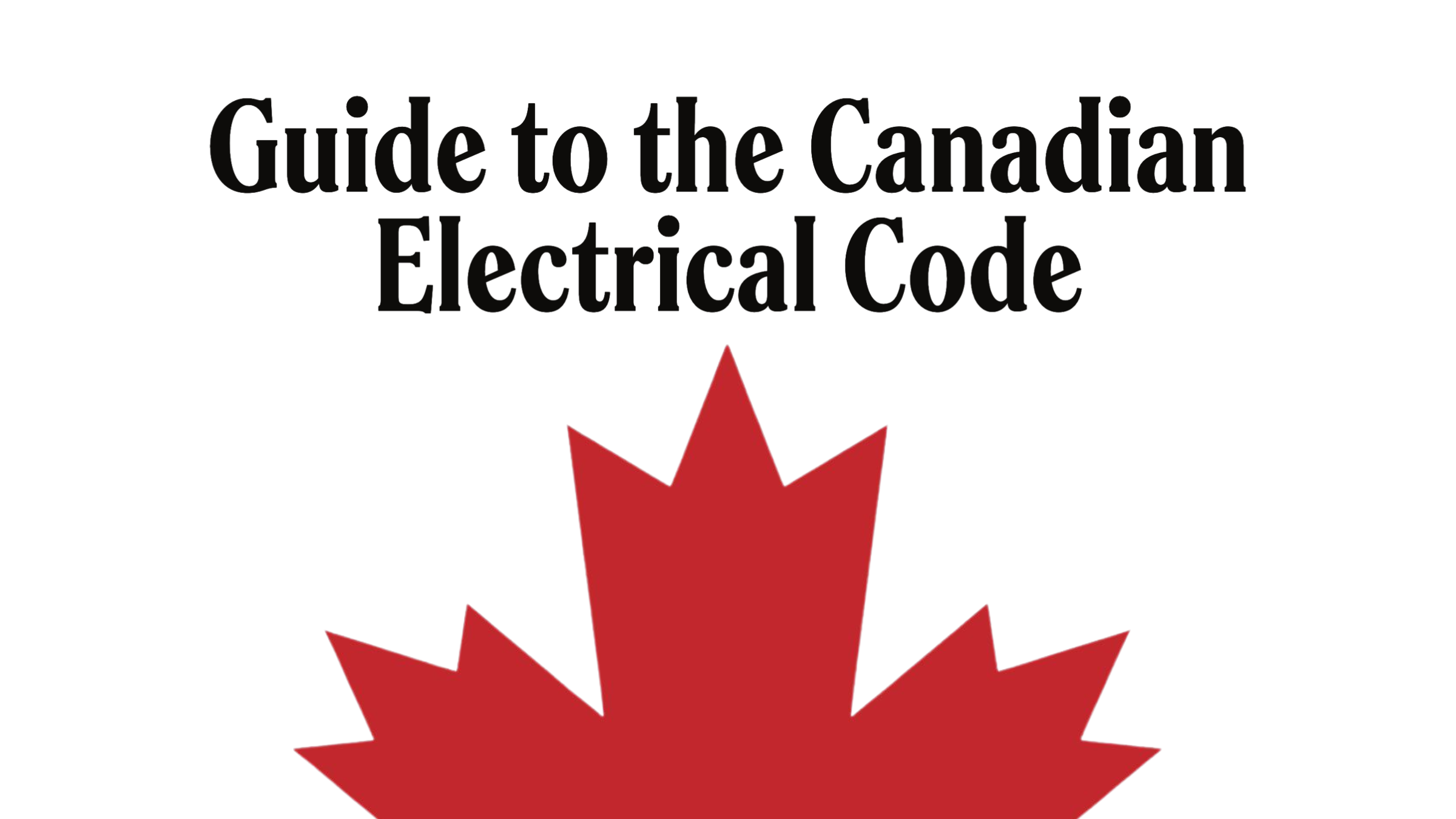Guide to the Canadian Electrical Code, Part 1[i], 26th Edition– A Road Map: Electrical Safety Regulation in Canada

August 12, 2024
William (Bill) Burr[i]
The Code is a comprehensive document. Sometimes, it can seem daunting to quickly find the information you need. This series of articles provides a guide to help users find their way through this critical document. This is not intended to replace the notes in Appendix B, or the explanations of individual requirements contained in the CEC Handbook but will hopefully provide some help in navigating the Code.

Electrical Safety Regulation in Canada – The Canadian Advisory Council on Electrical Safety (CACES)
This article is not specifically about the Canadian Electrical Code however it provides an important insight into the regulation of Electrical Safety in Canada including the safety of electrical products installed under the 26th Edition of the Canadian Electrical Code, Part 1 (CSA C21-1:24) which is now available at https://www.csagroup.org/store/. This article is timely since the annual meeting of the Canadian Advisory Council on Electrical Safety (CACES) was held this past June 10, 2024, in Vancouver, BC.
The meeting covered several topics related to electrical safety, including.
- reviewing working group comments on battery-powered medical electrical equipment and the scope of CSA SPE-3000:19 – Model code for the field evaluation of medical electrical equipment (MEE) and medical electrical systems (MES).
- online sales, incomplete field evaluations, and regulatory inquiries to Certification and Inspection Bodies about product compatibility with the Canadian Electrical Code, Part 1.
- discussions on revising the CE Code, Part I definition of “Approved” to align with CETA provisions.
- Updates were provided by CSA Group, Underwriters Laboratories Inc., and Underwriters Laboratories of Canada on recent publications and proposals.
- A table summarizing the number of Product Incident Reports (PIRs), and Certified Product Reports (CPRs) reported by accredited organizations.
In Canada, the Provinces and Territories are responsible for regulating health and safety. Each Province and Territory has specific legislation governing electrical safety in its jurisdiction, which includes adopting electrical codes and product standards and establishing or delegating an authority to administer the legislation. These authorities may be Provincial/Territorial Government Agencies, Municipalities or, in the case of delegated authorities, Crown Corporations, or other “at-arms-length agencies”[1]. Collectively they are referred to as Authorities Having Jurisdiction (AHJs).
Each Province and Territory designates a representative, usually the Chief Electrical Inspector or equivalent, to participate in the Canadian Electrical Code, Part I (CE Code) Committee and the Canadian Advisory Council on Electrical Safety (CACES). In addition, the Chief Electrical Inspectors from three of the larger municipalities participate as voting members of CACES and the CE Code Committee.
The Provinces and Territories all adopt the CE Code, with few amendments, which provides uniform electrical codes and electrical product standards throughout Canada. The Federal Canada Labour Code also references the CE Code. The Federal Government also plays a role through the establishment of the Standards Council of Canada (SCC), which promotes standardization and accredits Standards Development and Certification organizations for Canada. The SCC accreditation requirements include that Accredited Organizations must establish working relationships with applicable Authorities Having Jurisdiction for each regulated area of accreditation. This provides a framework upon which regulation of electrical safety in Canada takes place.
The Canadian Advisory Council on Electrical Safety was established in 1989, following the signing of the Canada – USA Free Trade Agreement (FTA) and in 1994 the North American Free Trade Agreement (NAFTA). Before these agreements there were only three organizations accredited by SCC for developing standards and certifying products in the electrical safety area for Canada – Underwriter’s Laboratories of Canada (ULC) for fire alarm-related electrical technologies, Canadian Gas Association (CGA) for electrical features of gas products, and Canadian Standards Association (CSA) for all other electrical products. Each of these organizations had separate interactions with regulatory authorities as required by the SCC accreditation requirements. With the implementation of the trade agreements all North American standards and certification bodies became eligible for accreditation by SCC.
Also at that time, the Provincial/Territorial and Municipal Chief Inspectors who were members of the Code committee regularly met as the Chief Electrical Inspectors Committee. With the signing of the FTA, it was expected that there would be many more Accredited Organizations (AOs) seeking interaction with the regulatory authorities. Rather than attend multiple meetings at various organizations around the countries, the already established Chief Electrical Inspectors Committee offered to function as a single regulatory advisory council for all accredited standards development and certification organizations and each AO, at the time, agreed. Thus, CACES was born.
Since its inception, CACES has been recognized as the central advisory authority for electrical safety by the SCC accreditation requirements. CACES provides a forum for discussing the safety, technical, and regulatory aspects of developing, promoting, and implementing electrical standards for Canada. The Council monitors and reports on problems encountered in the field concerning electrical safety and advises accredited organizations on those matters.
Membership of CACES consists of:
- the thirteen Provincial and Territorial regulatory authorities, and three municipal regulators, who are members of the CEC, Part I Committee,
- one member each representing SCC and Health Canada, and,
- Participating Accredited Organizations which include Standards Development Organizations (SDOs), Certification Bodies (CBs), and Field Evaluation Bodies (FEBs) are non-voting except for the election of officers and other non-regulatory matters.
- Associate non-voting members as requested by CACES.
The Responsibilities of CACES include the following:
- Coordinating with the SCC and AOs on matters impacting the National Standards System and discussing safety, technical, and regulatory aspects of developing electrical standards.
- Providing advice on the adoption and enforcement practices of uniform electrical safety standards and codes across Canada and recommending to AHJs the recognition of Other Recognized Documents (ORDs) for use in their respective jurisdiction. (ORD is another recognized document which is used to certify an electrical product where the standard is still under development)
- Providing advice to Accredited Standards Development Organizations on the development, revision, deletion or addition to codes and standards and the application of codes or standards to electrical products including the suitability of new products, new standards, new or specific requirements (such as ORDs) and electrical product certification, listing, and examination practices.
- Providing a forum for exchanging information on electrical safety incidents, accidents, and corrective actions.
- Monitoring AO activities and providing advice on testing, inspection, and certification processes for electrical products.
- Providing information on local regulations and rules for acceptance of products and feedback from regulators on problems with certified products in the field.
- Providing AOs with a forum to identify and seek input on problems associated with the application or interpretation of regulatory requirements.
Participating Accredited Organizations as members must comply with the following requirements:
- Providing updates on new, revised, and deleted standards and directories of certified product listings, and a list of published ORDs and updates on additions and deletions.
- Providing information on the evaluation, testing, electrical ratings, product markings and intended use of certified products, field evaluation reports and ORDs.
- Involvement with the development and maintenance of Canadian standards in the areas for which the organizations have been accredited and work to Canadian requirements and accepted Canadian standards for products intended for the Canadian marketplace.
- Providing regulatory authorities, at no cost, assistance on questions or problems regarding products certified or field evaluated by them.
- Upon receipt of a formal regulatory authority request to investigate an incident, product failure, or marking or label abuse:
- Initiate an investigation of the non-compliance.
- Submitting prompt investigation status reports to the regulatory authorities and reporting whatever actions, if any, have been taken.
- Where the regulatory authority considers the action taken by the AO inadequate, consider the regulatory authorities’ recommendation and modify its action plan (as appropriate) or provide a rationale to support its position.
- Providing corrective action for product failures in the marketplace in cooperation with the regulatory authorities.
- Ensuring that proper certification or field evaluation labels ensure that products comply with Canadian requirements.
- Ensuring that their requirements for certification or field evaluation in all regulatory authority jurisdictions remain consistent.
CACES is an independent organization, and its recommendations have no legal standing, however, because its membership includes important influencers in electrical safety at the Federal, Provincial, Territorial and Municipal levels, the Council’s decisions can have a major influence on how jurisdictions across Canada deal with similar issues concerning electrical safety and regulation.
Previous Installment: Section 16 Class 1 and Class 2 Circuits
In the next installment we will be discussing Section 18 – Hazardous locations.
[1] e.g., The Province of Alberta designates the Safety Codes Council for all aspects of the safety system, including accrediting municipalities, corporations and agencies that sell electrical installation permits and inspect the work conducted under them. The BC Safety Authority is the delegated authority in BC. The Electrical Safety Authority is the delegated authority in Ontario.
[i] William (Bill) Burr is an associate member of the Canadian Electrical Code, Part 1, Technical Committee and formerly Chair of the Canadian Advisory Council on Electrical Safety (CACES), Chief Electrical and Elevator Inspector for the Province of BC & the Northwest Territories, Director of Electrical and Gas Standards Development and Director of Conformity Assessment at CSA Group. Bill can be reached at Burr and Associates Consulting billburr@gmail.com..
[i] Source: CSA C22.1:24, Canadian Electrical Code, Part 1 – Safety Standard for Electrical Installations. © 2021 Canadian Standards Association. Please visit Store – CSA Group or call 1-800-463-6727. With the permission of CSA Group, the material is reproduced from CSA Group standard CSA C22.1:21, Canadian Electrical Code, Part 1 – Safety Standard for Electrical Installations. This material is not the complete and official position of CSA Group on the referenced subject, which is represented solely by the Standard in its entirety. While use of the material has been authorized, CSA Group is not responsible for the manner in which the data are presented, nor for any representations and interpretations. No further reproduction is permitted. For more information or to purchase standard(s) from CSA Group, please visit Store – CSA Group or call 1-800-463-6727.




![Guide to the Canadian Electrical Code, Part 1[i] – A Road Map: Section 52 — Diagnostic imaging installations](https://electricalindustry.ca/wp-content/uploads/2022/11/Guide-CE-Code-2-768x432.png)











